Playing with Dough for Special Needs and Primary School Children
The Educational Benefits of Playing with Dough for SEN and Primary School Children
Children love to play with dough. Its soft, malleable nature invites them to shape, squish, roll, and cut it into countless creations. But beyond the sheer fun of it, playing with dough offers numerous educational benefits, especially for special needs and primary school children. Whether it’s commercially available Play-Doh, homemade salt dough, or any other variant, this simple material can become a powerful learning tool.
Teachers can choose to introduce materials like playdough and allow children to play independently or with others. However, teacher involvement in play can enhance learning and encourage children to think differently. Teachers should observe and join in when appropriate to expand on children’s ideas and extend their learning. You can create season or theme-specific play dough activities such as these Halloween play dough Ideas.
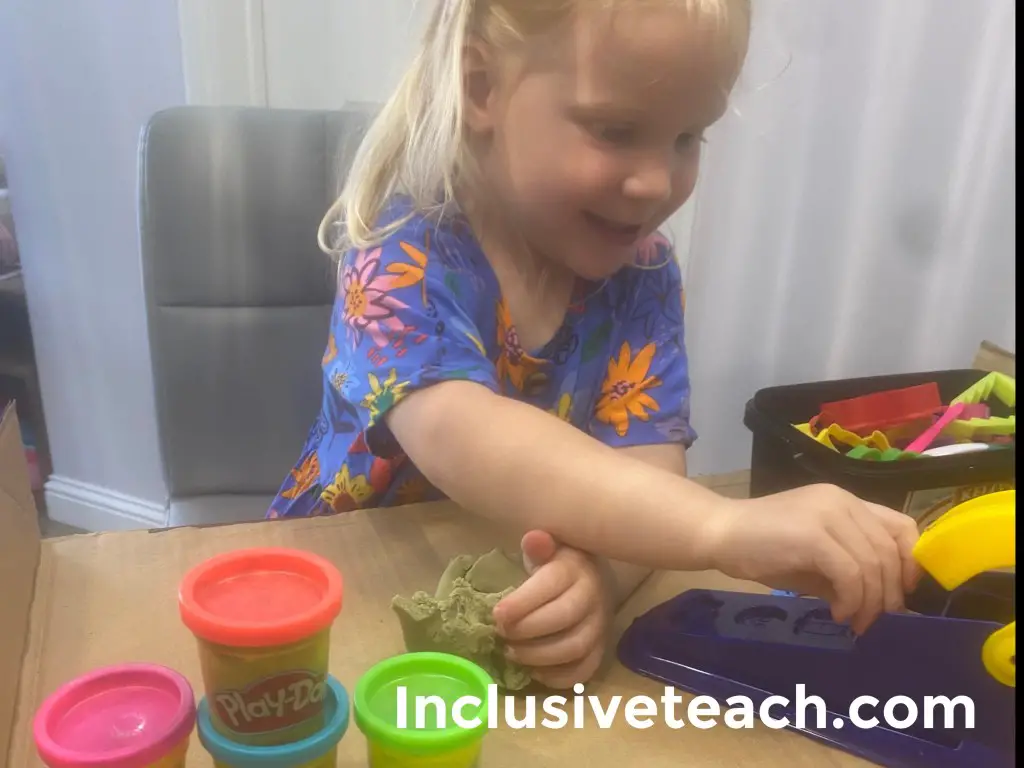
Using Play Dough for Sensory Development
Dough play provides a rich sensory experience that can enhance a child’s sensory development. The soft, pliable texture of dough makes it perfect for tactile exploration. As children knead and manipulate the dough, they’re also exploring concepts like hard, soft, wet, dry, sticky, and smooth. For children with sensory processing issues, dough play can have a calming effect and increase their comfort with different textures. You can implement dough play into interventions like finger gym and dough disco.
Tips for Enhancing Sensory Development Through Playing With Dough:
- Variety: Use different types of dough (like scented, textured, or coloured dough) to offer a range of sensory experiences.
- Incorporate Other Elements: Add elements like sand, rice, or beads when playing with dough for added texture.
- Temperature Play: Use warm or cold dough to introduce the sensation of temperature.
Fine Motor Skills Development
Manipulating dough helps children develop their fine motor skills and hand-eye coordination. The actions involved – such as rolling, squishing, cutting, and shaping – strengthen hand muscles and enhance dexterity. These are critical skills for tasks like writing, buttoning clothes, or using a computer.
Practical Tips for Enhancing Fine Motor Skills:
- Use Tools: Introduce tools like rolling pins, cutters, or tweezers to provide varied opportunities for motor development.
- Model It: Show children how to roll the dough into balls or snakes, flatten it into pancakes, or create more complex shapes.
- Extract Additional Elements: Similar to “Clever Fingers” fine motor tasks. Hide small toys or balls in the dough and the child has to manipulate it to get them out. Like a treasure hunt.
Creativity and Imagination using Play Dough
Playing with dough also spurs creativity and imagination. It’s an open-ended resource that children can transform into anything they imagine – from animals and people to landscapes and abstract shapes. This creative exploration can boost their self-confidence and self-expression. There is no reason not to provide prompts like a mat of easy-to-copy images or a background scene. So an A3 laminated picture of the Sea so they can create playdough ships or sea creatures.
Children who engage with play dough demonstrate curiosity, creativity, and imaginative thinking as they discuss various topics and use their imaginations to act out different scenarios.
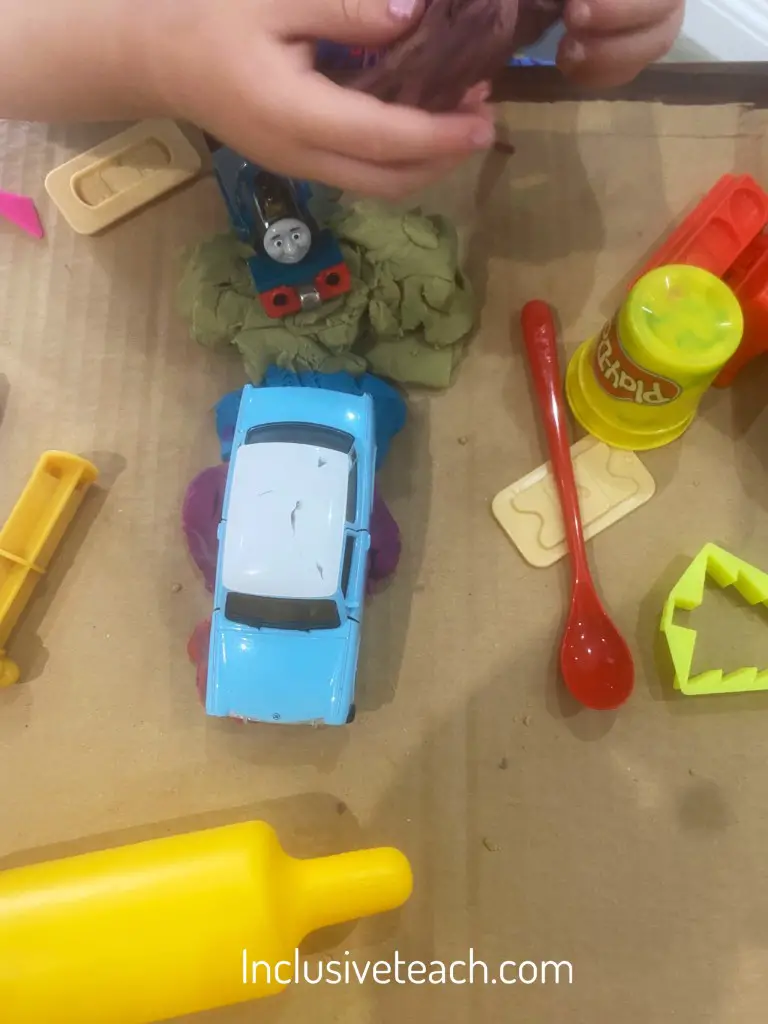
Practical Tips for Enhancing Creativity:
- Provide Props: Offer items like googly eyes, pipe cleaners, or popsicle sticks that children can incorporate into their creations.
- Theme Play: Suggest a theme or story-line to inspire their creations.
- Stop Motion Animation: If you have children that like tech create short films with their creations.
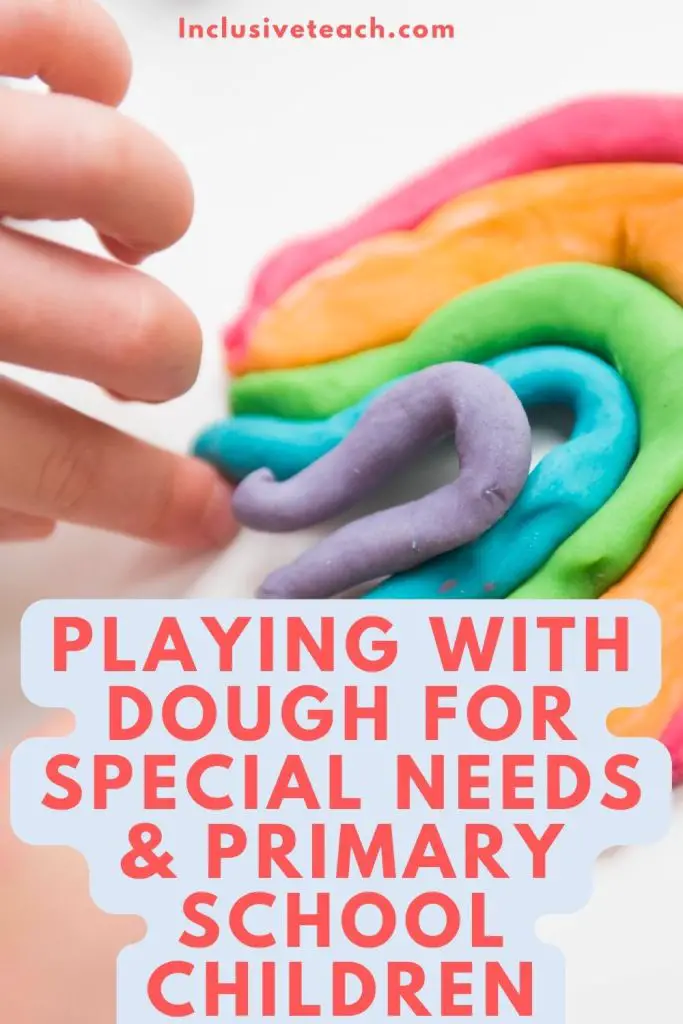
Enhance Language and Communication Skills Through Playing with Dough
Dough play can foster language and communication skills. As children create and play, they have opportunities to express their ideas, describe their actions, and respond to questions. For children with speech or language difficulties, dough play can be a non-threatening medium for communication.
Practical Tips for Enhancing Language Skills:
- Talk About It: Encourage children to describe what they’re doing or what they’ve made.
- Use Descriptive Language: Model the use of varied vocabulary and descriptive language.
Playing with Dough for Cognitive Development
Playing with dough can enhance cognitive development in several ways:
- Shapes and Sizes: Children can learn about different shapes and their properties. They can also explore concepts like big, small, long, and short.
- Counting and Maths: Children can form a specific number of shapes, compare quantities, or divide dough into halves or quarters.
- Problem Solving: Figuring out how to create a desired shape or structure involves problem-solving and critical thinking.
Practical Tips for Enhancing Cognitive Development:
- Ask Questions: Encourage children to think and make decisions by asking open-ended questions.
- Integrate Learning Goals: Incorporate specific learning goals into dough play activities.
Play Dough & Social-Emotional Development
Lastly, dough play can support social-emotional development. It can be a calming, therapeutic activity that helps children manage stress. It can also be a social activity where children learn to share resources, collaborate, and respect others’ creations.
Playdough offers several emotional benefits for children. Let’s explore them:
- Calming Effect:
- Playdough has a calming effect on many children. The physical experience of squeezing, rolling, and manipulating it can help reduce anxiety and restlessness.
- The pleasant texture—soft, squidgy, and pleasing to the touch—also contributes to its calming properties.
- Experience ‘Flow’:
- Engaging in playdough play allows children to experience a state of total absorption known as ‘flow’. In this state, they are entirely concentrated on what they are doing, fostering brain development, mental well-being, and a sense of purpose and achievement.
- Encourage children to build models or create characters with playdough, as this often leads to deep concentration and focus.
- Recreating Stories:
- Playdough helps children make sense of their lives and the stories they hear. Through playdough, they can express their emotions and ideas.
- Children often recreate real-life experiences using playdough. For example, after finding a worm outside, a child might make a playdough worm, complete with food, a house, and other elements. This process taps into caring instincts and empathy.
- Processing Emotions:
- There’s no right or wrong way to play with playdough. Children can express their feelings and emotions through their creations.
- As they mould and shape the dough, they process emotions and develop their emotional intelligence and communication skills.
- Self-Regulation and Stress Relief:
- The malleable nature of playdough provides a therapeutic outlet for emotional expression. Children can channel frustrations or anxieties into shaping and reshaping the dough.
- Pounding, flattening, and squeezing playdough offer healthy ways for children to cope with strong feelings.
- Sense of Competence and Achievement:
- Creating playdough objects allows children to feel competent and proud of their accomplishments. Whether they roll the dough, shape animals, or build structures, they experience a sense of achievement.
Playdough isn’t just about creativity and fine motor skills—it’s a powerful tool for supporting children’s emotional development
Practical Tips for Playing with Dough to Enhance Social-Emotional Development:
- Group Play: Arrange for small groups of children to work on a shared dough project.
- Respect Work: Teach children to respect and appreciate their own and others’ creations.
Example Learning Outcomes Linked to EYFS Framework
Here are 10 examples of how you may write a playdough activity as a lesson plan with references to areas of the early years framework.
Title: Play Doh Fun!
Overview: This play-doh lesson plan is designed to support various areas of children’s learning and development through open-ended play-doh activities.
Learning Objectives Linked to Playdough:
- Fine Motor Skills Development (Physical Development – Moving and Handling) – Children will roll snakes, pinch shapes, and press cookie cutters to build fine motor strength.
- Imaginative Play (Expressive Arts and Design – Exploring and Using Media and Materials) – Children will be encouraged to engage in role play scenes with their play doh creations.
- Sensory Exploration (Understanding the World – The World) – Children will knead, poke, smoosh, and manipulate the play doh to explore its unique sensory qualities.
- Problem Solving (Mathematics – Numbers) – Children will be presented with challenges like making a playdoughpizza and tasked with solving how to make each ingredient.
- Collaborative Play (Personal, Social and Emotional Development – Making Relationships) – Children will be encouraged to build together, take turns, and share ideas during paired play-doh activities.
- Language Development (Communication and Language-Speaking) – Open discussion of play doh experiences and creations will be facilitated throughout the activities.
- Creative Expression (Expressive Arts and Design – Exploring and Using Media and Materials) – Children will be given tools and loose parts to enhance their unique play doh creations.
- Following Instructions (Literacy – Reading) – Step-by-step instruction cards will be used to guide children in making specific play doh designs.
- Shape Recognition (Mathematics – Shape, Space and Measure) – Children will use cookie cutters and shape tools to create recognizable shapes with their play doh.
- Self-Confidence Building (Personal, Social and Emotional Development – Self-Confidence and Self-Awareness) – Children will be praised for their efforts and unique ideas throughout the play doh activities.
Adapting Playing With Dough For SEN
Here are some tips for adapting play dough activities for children with special educational needs (SEN), how you use these adaptations will depend on the individual. I would be especially mindful of using it with children with PICA. They may need a fully edible homemade dough:
- Texture/temperature: Play with different textures of play dough like bumpy, silky smooth, sticky. Offer warm/cold play dough which can be soothing.
- Finger/hand strength: Have play dough that is firm enough to provide resistance building finger muscles. Or use dough that is softer for those with low muscle tone.
- Sensory input: Add textured items like glitter, beads, pom poms for children who seek tactile input.
- Cause and effect: For those seeking sensory cause and effect, add tools that imprint or make marks like shape cutters or cookie cutters.
- Gross motor skills: Provide a large play space and larger play dough tools/utensils for whole arm movements to work on skills.
- Visual stimuli: Add bright food colours – Gel based food colouring is better, or shapes that contrast to stand out more visually.
- Multi-sensory: Combine play dough with other items of different textures like feely bottles, textured balls for a multi-sensory experience.
- Calming activity: Offer play dough as a calming activity for children who are overstimulated or as a transition between activities.
What Does The Research Say About Playing With Dough and Childhood Development?
Playing with dough, such as playdough or plasticine, has been found to have a positive impact on a child’s development. It can help improve motor skills, coordination between the eyes and fingers, and the ability to recognise geometric shapes. Finger painting games have also been shown to increase children’s creativity. Both playdough and finger painting games are considered beneficial for children’s development.
Play Dough Recipes
Here are 4 easy, low cost, play dough recipes suitable for primary school children. Involving the children allows them to develop literacy and numeracy skills as they read the recipe, measure ingredients and mix the dough:
Basic Play Dough Ingredients:
- 2 cups plain flour
- 1 cup salt (reduce if your children are likely to eat it)
- 2 tablespoons vegetable oil
- 2 teaspoons cream of tartar
- 1 cup water
- Food colouring (optional)
Method:
- Combine the flour and salt in a saucepan.
- Add the oil, cream of tartar, water and food colouring (if using) and mix well.
- Cook over a medium heat, stirring constantly, until a dough forms.
- Remove from heat and allow to cool before using or storing in an airtight container.
Rainbow Play Dough Ingredients:
- Basic play dough recipe (see above)
- Different food colourings
Method:
- Make the basic play dough recipe and divide into portions.
- Add a few drops of different food colouring to each portion and knead until fully combined.
- Store each colour in a separate airtight container or bag for playtime fun!
Play Dough with Glitter Ingredients:
- Basic play dough recipe
- Glitter
Method:
- Make the basic play dough recipe.
- Knead a small amount of glitter into portions of the uncooked dough.
- Cook and serve with a sprinkling of glitter on top.
Scented Play Dough
- Basic play dough recipe
- A few drops of essential oil such as lavender, lemon or peppermint
- Ginger can be added for a fantastic Christmas recipe to go alongside our Christmas sensory activities.
Method:
- Make the basic play dough recipe.
- Knead in a few drops of essential oil for a sensory element. Ensure you check for allergies to essential oils first.
- Store in an airtight container.
Playing With Dough Final Thoughts
Playing with dough is more than just a fun activity; it’s a multi-faceted learning experience that supports the holistic development of children. As educators, we can harness the power of this versatile material to create engaging, hands-on learning experiences that cater to a wide range of abilities and learning styles. Whether it’s developing fine motor skills, sparking creativity, or enhancing cognitive abilities, the humble dough has a lot to offer in an educational setting.
References Related to Playing With Dough and Children’s Development:
Ardianti, T., Purwoko, B., & Izzati, U. A. (2023). The Effects of Playing Playdough on the Ability to Recognize Geometric Shapes in Kindergarten. Studies in Philosophy of Science and Education, 4(1), 17-21. https://doi.org/10.46627/sipose.v4i1.273
Goldhaber, J. 1992. Sticky to dry; red to purple: Exploring transformation with playdough. Young Children 48 (1): 26–28
Setiawati, E. (2022). The effect of playdough games on children’s creativity in early childhood education. Gagasan Pendidikan Indonesia, 3(1). https://doi.org/10.30870/gpi.v3i1.15122
Sutapa, Panggung & Prasetyo, Yudik & Arjuna, Fatkhurahman & Prihatanta, Hadwi. (2018). Differences of Influence of Playing Playdough and Puzzles on Fine Motor Skills and Logical-Mathematical Intelligence in Early Childhood. 10.2991/yishpess-cois-18.2018.44.



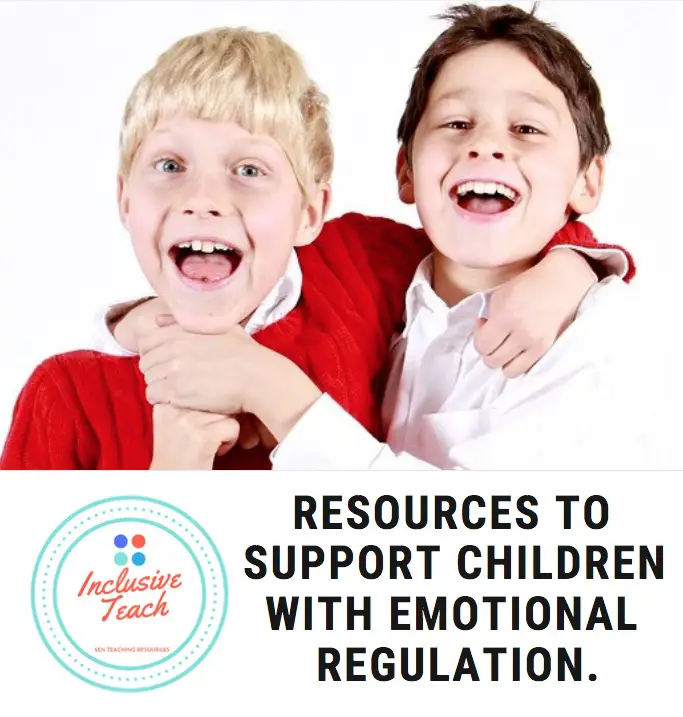
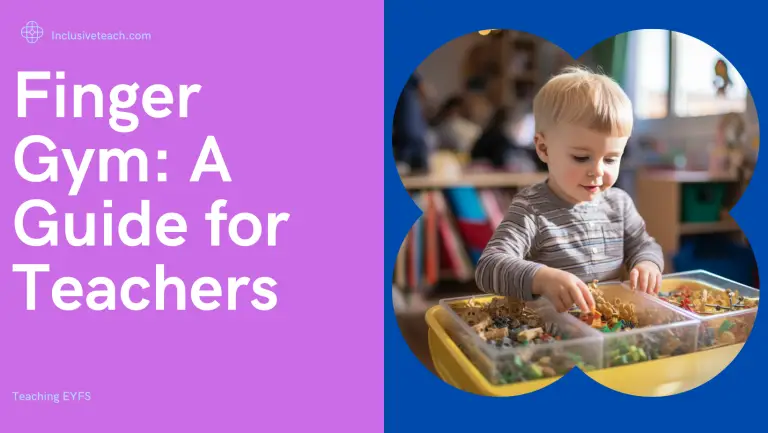


One Comment